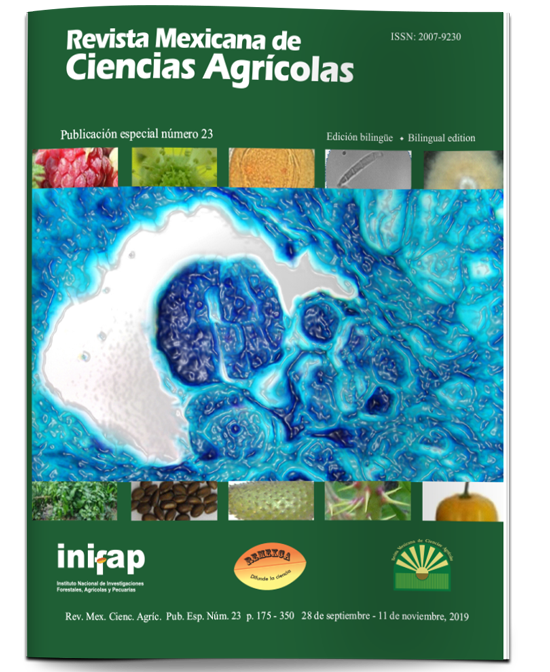New causes of rot in rubber sting panel: case Fusarium spp.
DOI:
https://doi.org/10.29312/remexca.v0i23.2027Keywords:
characterization, culture media, fungicide sensitivity, identificationAbstract
Moldy rot on the rubber sting panel decreases the yield and regeneration of its bark. The objective was to identify the causative agent of the disease in San Juan Bautista Tuxtepec, Oaxaca and evaluate its in vitro sensitivity to fungicides. To this end, tissue from the diseased sting panel was collected and made insulations. The isolates were characterized in the nutritive media PDA (papa-dextrose-agar), CLA (carnation leaves-agar), FLA (liquid fermentation-agar), CDA (coffee-dextrose-agar) and ZA (carrot-agar). Growth rates were evaluated and pathogenicity tests were carried out in the laboratory and in the field, as well as in vitro sensitivity to Mancozeb 70%, Benomilo, Carbendazin, Propiconazole, Chlorothalonil, and Carboxamide, in 10 treatments and eight repetitions. The results showed four isolates of the genus Fusarium, which showed polymorphism according to the culture medium, with radial growth and marked rings. Microconidia and macroconidia dispersed in the mycelium and white, orange and blue sporodochs were observed at 36 days. The growth rate varied with the nutrient medium and the inoculated strain. F. circinatum, F. lateririum, F. decemcellulare and F. mangiferae were identified. In the laboratory pathogenicity tests all inoculated strains were positive and in the field only F. circinatum and F. mangiferae. The sensitivity bioassay showed fungicide-dependent response and isolation. These results allow us to conclude that the species F. circinatum, F. mangiferae, F. lateririum and F. decemcellulare can cause moldy rot in the sting panel of clone IAN 710. This is a first report that involves these species. Its control depends on the species of Fusarium and the fungicide used.
Downloads
Downloads
Published
How to Cite
Issue
Section
License
The authors who publish in Revista Mexicana de Ciencias Agrícolas accept the following conditions:
In accordance with copyright laws, Revista Mexicana de Ciencias Agrícolas recognizes and respects the authors’ moral right and ownership of property rights which will be transferred to the journal for dissemination in open access. Invariably, all the authors have to sign a letter of transfer of property rights and of originality of the article to Instituto Nacional de Investigaciones Forestales, Agrícolas y Pecuarias (INIFAP) [National Institute of Forestry, Agricultural and Livestock Research]. The author(s) must pay a fee for the reception of articles before proceeding to editorial review.
All the texts published by Revista Mexicana de Ciencias Agrícolas —with no exception— are distributed under a Creative Commons License Attribution-NonCommercial 4.0 International (CC BY-NC 4.0), which allows third parties to use the publication as long as the work’s authorship and its first publication in this journal are mentioned.
The author(s) can enter into independent and additional contractual agreements for the nonexclusive distribution of the version of the article published in Revista Mexicana de Ciencias Agrícolas (for example include it into an institutional repository or publish it in a book) as long as it is clearly and explicitly indicated that the work was published for the first time in Revista Mexicana de Ciencias Agrícolas.
For all the above, the authors shall send the Letter-transfer of Property Rights for the first publication duly filled in and signed by the author(s). This form must be sent as a PDF file to: revista_atm@yahoo.com.mx; cienciasagricola@inifap.gob.mx; remexca2017@gmail.
This work is licensed under a Creative Commons Attribution-Noncommercial 4.0 International license.



